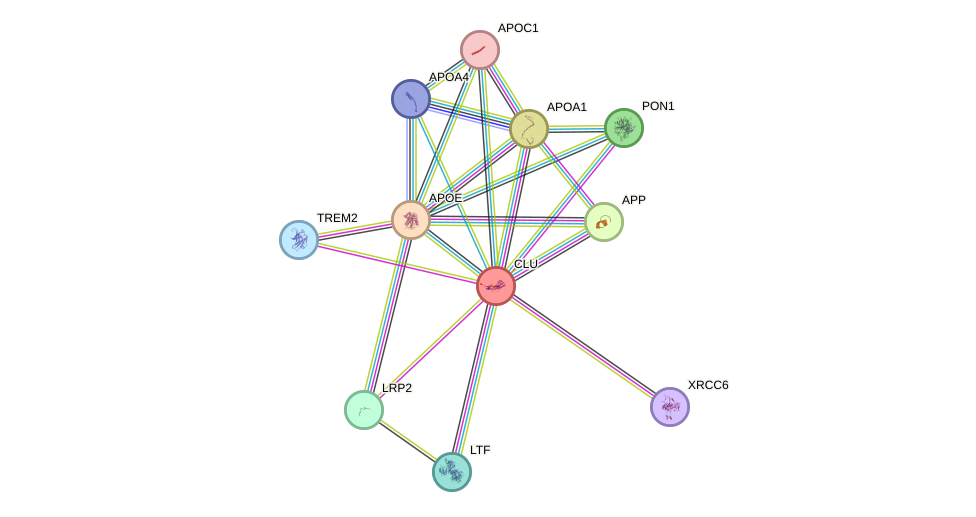GenAge entry for CLU (Homo sapiens)
Gene name (HAGRID: 220)
- HGNC symbol
- CLU
- Aliases
- SGP-2; SP-40; TRPM-2; KUB1; CLU1; CLU2; CLI; APOJ
- Common name
- clusterin
Potential relevance to the human ageing process
- Main reason for selection
- Entry selected based on evidence directly linking the gene product to ageing in a non-mammalian animal model
- Description
The functions of CLU are still unclear, but it may be involved in apoptosis. In flies, overexpression of human clusterin increased stress resistance and significantly extended lifespan [2116]. CLU-null mice had 50% less brain injury following neonatal hypoxia-ischemia [1748]. Inflammation was more severe in CLU-deficient mice [1749].
In humans, serum levels of CLU increase during type 2 diabetes and coronary heart disease [1230] and genome-wide association studies have identified variants of CLU to be associated with Alzheimer's disease [2003][2004]. There is however no direct evidence linking CLU to human ageing.
Cytogenetic information
- Cytogenetic band
- 8p21-p12
- Location
- 27,596,917 bp to 27,615,031 bp
- Orientation
- Minus strand
Protein information
- Gene Ontology
-
Process: GO:0000902; cell morphogenesis
GO:0001774; microglial cell activation
GO:0001836; release of cytochrome c from mitochondria
GO:0002576; platelet degranulation
GO:0006629; lipid metabolic process
GO:0006956; complement activation
GO:0006958; complement activation, classical pathway
GO:0009615; response to virus
GO:0017038; protein import
GO:0032286; central nervous system myelin maintenance
GO:0032436; positive regulation of proteasomal ubiquitin-dependent protein catabolic process
GO:0032463; negative regulation of protein homooligomerization
GO:0032760; positive regulation of tumor necrosis factor production
GO:0043691; reverse cholesterol transport
GO:0045087; innate immune response
GO:0045429; positive regulation of nitric oxide biosynthetic process
GO:0050821; protein stabilization
GO:0051092; positive regulation of NF-kappaB transcription factor activity
GO:0051131; chaperone-mediated protein complex assembly
GO:0051788; response to misfolded protein
GO:0061077; chaperone-mediated protein folding
GO:0061518; microglial cell proliferation
GO:1900221; regulation of beta-amyloid clearance
GO:1901214; regulation of neuron death
GO:1901216; positive regulation of neuron death
GO:1902004; positive regulation of beta-amyloid formation
GO:1902230; negative regulation of intrinsic apoptotic signaling pathway in response to DNA damage
GO:1902430; negative regulation of beta-amyloid formation
GO:1902847; regulation of neuronal signal transduction
GO:1902949; positive regulation of tau-protein kinase activity
GO:1902998; positive regulation of neurofibrillary tangle assembly
GO:2000060; positive regulation of protein ubiquitination involved in ubiquitin-dependent protein catabolic process
Cellular component: GO:0005576; extracellular region
GO:0005615; extracellular space
GO:0005634; nucleus
GO:0005737; cytoplasm
GO:0005739; mitochondrion
GO:0005783; endoplasmic reticulum
GO:0005794; Golgi apparatus
GO:0005829; cytosol
GO:0009986; cell surface
GO:0031012; extracellular matrix
GO:0031093; platelet alpha granule lumen
GO:0031966; mitochondrial membrane
GO:0034366; spherical high-density lipoprotein particle
GO:0042583; chromaffin granule
GO:0043234; protein complex
GO:0048471; perinuclear region of cytoplasm
GO:0070062; extracellular exosome
GO:0072562; blood microparticle
GO:0097418; neurofibrillary tangle
GO:0097440; apical dendrite
Hide GO termsFunction: GO:0005515; protein binding
GO:0016887; ATPase activity
GO:0031625; ubiquitin protein ligase binding
GO:0051087; chaperone binding
GO:0051787; misfolded protein binding
Protein interactions and network
- Protein-protein interacting partners in GenAge
- EGFR, FOS, NFKB1, TNF, XRCC6, BAX, GRB2, LRP2, APP, PON1, HSPD1, MAPK9, MDM2, H2AFX, NFKBIA, CLU, ELN, PDGFRA
- STRING interaction network

